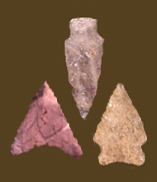
|
CLOVIS Defining Attributes Chronology Description Haft Element: Concave base; lower side edges are ground, and this grinding marks the extent of the haft element. Size: An assessment of 44 Clovis points found in Maryland reported lengths ranging from 33 to 102.5 mm, with a mean of 60.03 mm. A large standard deviation (15.02 mm) indicated a great degree of variability in lengths. (The three longest points, 102.5, 90.3, and 89.6 mm, were at least 17 mm bigger than the next longest point, which led Brown (1979) to suggest they may not have been originally found in Maryland). Widths ranged between 17 and 39.2 mm, with a mean of 26.07 mm and standard deviation of 4.86 mm. Thicknesses were between 4.6 and 11 mm, with a mean of 7.13 mm and a standard deviation of 1.38 mm. The length-to-width ratio of this Clovis assemblage ranged from 1.51 to 3.75, with a mean of 2.29. This seems to be a useful metric for distinguishing Clovis from the shorter, stubbier Middle Paleo points, which had a ratio range of 1.26 to 2.75, with a mean of 1.64 (Brown 1979). On average, Clovis points from the Maryland Coastal Plain were slightly shorter (54.35 mm, excluding the three longest points of questionable provenience) than those from the Piedmont (58.8 mm) or Western Maryland (64.5 mm), although the sample sizes for the latter two regions were quite small, and there was considerable overlap in individual point lengths. However, the regional size differences, if real, may reflect a partial reliance on smaller cobbles as a source material in the Coastal Plain, particularly the Eastern Shore. In Virginia, the McCary Survey is an inventory of over 1000 fluted points that have been recorded in the state since 1947. Presumably it includes non-Clovis fluted points (although that assumes one accepts the validity of other fluted types in Virginia), but the inventory is believed to be skewed toward or dominated by Clovis points (Gardner and Verrey 1979; Hranicky 2008). The data shows that these fluted points range in length from 18 to 171 mm, with a width of 12 to 52 mm, and a thickness of 3 to 14 mm. The smaller and thinner points in particular could be non-Clovis. An examination of 66 Clovis points in New York found that they ranged from 25 to 125 mm in length, with most between 60 and 90 mm. Thickness ranged from 3 to 10 mm, with most between 5 and 8 mm (Ritchie 1971). The variability in length may reflect the original size of the source material, functional differences, and/or breakage and resharpening. Technique of manufacture: Combinations of soft percussion and pressure flaking. Flaking of the blank is often designed to create a well-defined medial ridge for the subsequent channel flake to follow during removal. Alternatively, more than one channel flake was struck from each face to provide guide ridges for subsequent flakes. Material: In a study of 44 Clovis points from across Maryland, 37 (84%) were made from various cryptocrystalline stones, while 4 (9%) were quartz and 3 (7%) were quartzite (Brown 1979). In far Western Maryland, siltstone was also used for fluted points (Wall 1992). On the Delmarva Peninsula, some fluted points were made from ironstone, orthoquartzite, and petrified wood (Lowery 2002). Elsewhere in the Mid-Atlantic, occasional use of other materials such as slate and rhyolite has been reported (Hranicky 2008). Discussion Clovis points are mostly commonly recovered as surface finds, but several well-known excavated sites are located in the mid-Atlantic region. In Virginia, there is the Thunderbird site complex, the Cactus Hill site, and the Williamson site, where approximately 200 fluted points have been found (McAvoy 2003). In Pennsylvania, there is the Shoop site and the Shawnee-Minisink site. Clovis points have been found at several Maryland sites. The Higgins site (18AN489), a small, short-term game processing station in Anne Arundel County, contains the only intact Paleoindian deposit that has been excavated on the Western Shore of the Chesapeake, and yielded quartz Clovis fragments (Ebright 1992). The Nolands Ferry I site (18FR17) in Frederick County is a well-preserved, multi-component site with occupations from the Paleoindian through the Late Woodland. The Pierpoint site (18MO41), located along the Potomac fall line, has yielded several fluted points from a plowzone context (Dent 1995). Paleoindian sites on Maryland’s Eastern Shore include the Paw Paw Cove complex of sites on Tilghman Island (18TA211a, TA212a, TA212b, TA213), where at least 33 fluted bifaces have been recovered along the eroded shoreline, with additional examples excavated from stratified contexts (Lowery 1989, 2002, 2003). Other Maryland Eastern Shore sites with Clovis points include Nassawango (18WO23) and Henckel Farm (18TA347). There are no radiocarbon dates for Clovis in Maryland or Delaware. For many years, the Clovis point was widely believed to be characteristic of the oldest culture in Maryland, but that view is starting to break down as apparently earlier sites are being discovered throughout the Americas. At least one bifacial blade style that may predate the Clovis has been reported in the East. Recovered from the deepest levels at the Hardaway site in North Carolina and given the name Hardaway Blade (Coe 1964), it has a broad, thin, pentagonal blade with a concave, thinned, and flaring base. McAvoy and McAvoy (1997) recovered a similar biface, too thin to permit fluting, from a pre-Clovis horizon, perhaps older than 12,000 BC, at the Cactus Hill site in Virginia. However, pre-Clovis bifaces have not been identified yet in Maryland. Defined in Literature References |
![]()
Search by Shape:
(See Projectile Point Typology) |

|
Thank you for visiting our website. If you have any
questions, comments, Copyright © 2002 by |

|

